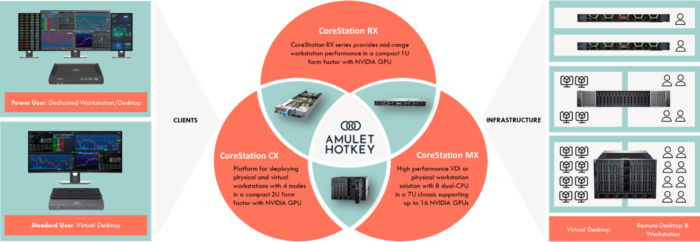Home > News & Events >

Hybrid Desktop Environments
06 October 2023
We talk all the time about the hybrid cloud, the ability to deliver infrastructure services from multiple cloud service providers including those existing on-premises deployments. The question is why do organizations look to the hybrid cloud for their infrastructure solutions?
The simple answer is that they look to solve their business IT requirements by taking advantage of the best cloud provider to solve particular use cases. For example, service provider A may provide the most appropriate cloud storage solution, while service provider B provides the best database as a service solution. The key takeaway here is that the cloud service selected is typically matched to the use case being solved. It’s like choosing the best tool for the job.
Moving on to end user computing and remote desktops, how is what we just discussed related to delivering desktop services? After all, a desktop is just a desktop, right? Not quite!
When it comes to delivering desktops, typically there is not a “one size fits all” solution. There could be a number of different use cases whereby different employees have different needs and requirements. From performing basic office tasks to high-end graphical applications and data analytics that require high levels of compute power or specialist hardware.
Typically, at this point, it is highlighted that VDI (virtual desktop infrastructure) answers the question of being that solution that can fit all sizes. While that is probably true given the maturity and advancement in VDI technology, it doesn’t come without issues. Those issues being the high costs.
For example, if you take the delivery of hardware accelerated graphics. The cost of the graphics cards to deliver this requirement are substantial, and coupled with the cost of the hosting server infrastructure can make the cost per user even higher. This is primarily down to the limited density or number of users that can have access to the graphics capability of the server. The number of users comes down to the configuration of the graphics cards.
If you take a NVIDIA Tesla T4 graphics card configured with a 2GB buffer and running 2 monitors with a resolution of 3840×2160 then you will only be able to host 8 users on this card. With two cards in the server (typically a 2U server) then you will be able to host a maximum of 16 users. Compared with non-GPU based servers which could potentially run 100+ users in the same footprint.
Now, we aren’t saying the VDI is bad, on the contrary, it is the perfect solution when matched with the correct use case and for a large number of organizations it was a lifesaver during the pandemic. In fact, I would go as far as to say that 2020 was quite possibly the year of VDI if ever there was going to be one and that could well be down to the global pandemic that we all faced. But now organizations are facing a new pandemic. One of spiraling costs coupled with the pressures of having to continually improve service delivery to employees. You could easily argue that that has always been the case.
So, back to subject of this article and hybrid desktop environments…
While VDI has made leaps and bounds in market share as well as technical capabilities, it has not fully replaced the desktop as we know it. There are still plenty of physical desktop (including laptops) still in use today and that will continue to be the case for the foreseeable future. What is required is a solution that embraces VDI, physicals desktops, and high-end desktops or workstations as they are more commonly known as and therefore allowing the most appropriate solution to be deployed to solve the use case in question. This is where the hybrid element comes into play with a mixture of physical and virtual desktops and workstations being deployed depending on the use case.
Amulet Hotkey has the answer to this problem and can enable organizations to host virtual and physical desktops and workstations all from the same platform. In fact, this solution is unique in the market as it provides an end-to-end solution as Amulet Hotkey are also leaders in the thin and zero clients space delivery optimized end points for delivering remote desktop solutions.

remote desktop solutions
Corestation
At the heart of the Amulet Hotkey infrastructure is the CoreStation range of servers. Available as 1U rack mount or modular 2U and 8U chassis, each CoreStation compute node has been optimised for performance and density. Especially when it comes to delivering hardware accelerated graphics where CoreStation can support more GPU resource than any other vendor.
As CoreStation is based on server technology, each node can support either a physical workstation on a 1:1 user basis or it is capable of running a hypervisor enabling it to run multiple virtual desktop instances and any virtual desktop management software. Whichever the CoreStation platform deployed, all are optimized for hardware accelerated graphics and provide greater user density than standard off the shelf solutions.
Common across the entire platform is the ability to manage all CoreStation nodes remotely, regardless of form factor, from a single management console that not only makes management simple but also to allow service provider partners to use Amulet Hotkey solution to deliver Desktop-as-a-Service solutions.
In summary …
Amulet Hotkey solutions enable organizations to deploy a hybrid remote desktop environment to its employees. The ability to mix and match the different types of workloads against the diverse employee requirements and use cases is unique in the market. Add in the client-side hardware devices serves for a complete end to end remote desktop solution that can fit all sizes.
By Peter Von Oven, Enterprise Solutions Manager at Amulet Hotkey